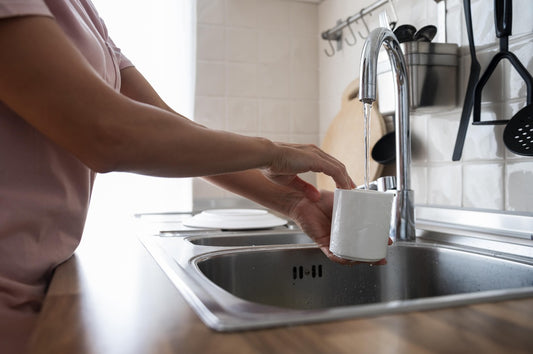Water is the essential component of life, pivotal to numerous bodily functions, including regulating body temperature, eliminating toxins, and aiding digestion. Despite its importance, the sad reality is that clean, uncontaminated water is not accessible to all. This underlines the significance of water filters, devices that ensure we have safe, potable water at our fingertips.
However, it's not enough just to install a water filter system; maintenance, particularly timely replacement of filter cartridges, is crucial. In this guide, we delve into the world of water filters, focusing specifically on the heart of these systems, the replacement cartridges. This guide will equip you with knowledge on different types of water filters, the need for replacement cartridges, when and how to replace them, and the key considerations when choosing a replacement cartridge.

Why Water Filters?
The Importance of Clean Drinking Water
Water is a universal solvent, meaning it's adept at dissolving a variety of different substances. While this property makes it beneficial for various processes within our bodies, it also means that water can contain harmful contaminants picked up on its journey. Consuming such contaminated water can have adverse effects, from mild discomfort to serious illnesses, including gastrointestinal disorders, reproductive problems, and neurological diseases. Therefore, clean drinking water is a vital, non-negotiable aspect of our health.
Benefits of Using a Water Filter
Water filters, depending on their type and capabilities, can remove a wide range of contaminants, such as bacteria, viruses, heavy metals, chlorine, fluoride, and volatile organic compounds (VOCs). By doing so, they not only protect our health but also improve the water's taste and odor, making our daily hydration a more enjoyable experience. Additionally, they can reduce the dependence on bottled water, thus contributing to a decrease in plastic pollution.
Types of Water Filters

Image by macrovector on Freepik
Activated Carbon Filters
Activated carbon filters are one of the most common types of water filters. They operate by attracting and trapping impurities within their pore structure through a process called adsorption. These filters are especially effective against organic compounds, chlorine, and its by-products, enhancing the taste and odor of water. However, they aren't as effective in eliminating salts, minerals, and dissolved inorganic substances.
Reverse Osmosis
Reverse Osmosis (RO) is a technologically advanced filtration method. It involves passing water through a semipermeable membrane, which filters out a broad spectrum of contaminants, including heavy metals, salts, and certain microbes. The result is highly purified water. However, RO systems produce a significant amount of wastewater and also remove beneficial minerals from the water.
Alkaline/Water Ionizers
These systems use a process called electrolysis to separate water into two streams, one alkaline and one acidic. The alkaline stream is used for drinking and cooking, as it's believed to offer certain health benefits, such as neutralizing acid in the bloodstream and boosting metabolism. However, more research is needed to validate these claims.
UV Filters
UV filters are a relatively new but highly efficient technology. They leverage the germicidal capabilities of ultraviolet light to kill or render harmful microbes ineffective, ensuring your water is free from biological contaminants. However, UV filters alone don't remove other contaminants like heavy metals, salts, and chemicals.
Infrared Filters
Infrared filters utilize heat and light to soften hard water, which contains high levels of calcium and magnesium. By changing the structure of these minerals, infrared filters improve the palatability and healthfulness of the water.
Sediment Filters
As the name suggests, sediment filters are designed to remove larger particulates like sand, dust, and rust. They're often used in conjunction with other filtration methods to protect them from larger particles that could clog or damage them.
Understanding Replacement Cartridges
What Are Replacement Cartridges?
At the core of any water filter system are the cartridges, the workhorses that do the heavy lifting of filtering and purifying the water. These cartridges are composed of various materials designed to trap or neutralize contaminants as water passes through them. However, just like any other filter, these cartridges have a lifespan. Over time, trapped contaminants accumulate, reducing the filter's effectiveness and necessitating replacement.
Knowing When to Replace
Visual Checks
Cartridges should be regularly checked for signs of wear. Discoloration, clogging, or visible damage can indicate that it's time for a replacement.
Water Taste and Smell
A change in water's taste or smell is often a clear indication that your filter isn't performing as it should, implying that it's time to replace the cartridge. A return of a chlorine taste or smell, for example, could mean the activated carbon in the cartridge is exhausted.
Pressure and Flow Rate
Another sign that your cartridge needs replacement is a significant decrease in water flow or pressure. If the water starts trickling out of your faucet, it's likely the cartridge is clogged with impurities and needs to be replaced.
How to Choose Replacement Cartridges

Image by macrovector on Freepik
Consider Your Water Source
The contaminants in your water source heavily influence the choice of your replacement cartridge. Tap water and well water, for example, tend to have different contaminants. Tap water is usually treated, so it may contain chemicals like chlorine, while well water could contain more organic matter and sediments.
Identify Filter Type
Knowing the type of your water filter system is vital as it determines the kind of replacement cartridge you need. For example, an RO system requires a different cartridge than an activated carbon filter system.
Choose Compatible Cartridges
Cartridges are not universally compatible across different filter models or brands. Always ensure that the replacement cartridge is designed to fit your specific filter model. Using an incompatible cartridge can damage the system or reduce filtration efficiency.
Understand Micron Ratings
Micron ratings denote the size of the particles a filter can remove. A lower micron rating means the filter can remove smaller particles. Depending on your water source and the contaminants present, you might need a cartridge with a lower or higher micron rating.
Look for Certifications
Certified cartridges are those that have undergone testing by third-party organizations to meet certain standards of safety and performance. Certifications provide assurance about a product's quality, reliability, and efficacy.
Replacing The Cartridge
Steps to Replace Cartridge
Although the specific steps can vary depending on the filter model, cartridge replacement usually involves turning off the water supply, removing the old cartridge, installing the new one, and turning the water supply back on. Always consult your filter's manual for detailed instructions.
Cartridge Maintenance
Tips for Maintenance
Proper maintenance can enhance your cartridge's performance and lifespan. This includes regular checks, ensuring the cartridge is installed correctly, and timely replacements. It's also important to sanitize the filter housing each time you change the cartridge to prevent bacterial growth.

Image by macrovector on Freepik
Conclusion
Ensuring a consistent supply of clean, safe drinking water goes beyond just installing a water filter. Understanding how these systems and their cartridges work, recognizing when it's time to replace these cartridges, and knowing how to choose and replace them are all critical aspects of maintaining water filter systems.
With this guide, we hope you're better equipped to manage your water filter system, guaranteeing it works optimally to provide you with pure, contaminant-free water day after day.
FAQs
How often should I replace my water filter cartridge?
The replacement frequency can vary significantly depending on the water source quality and usage. However, a good rule of thumb is to replace it every 6-12 months.
What happens if I don't replace my filter cartridge?
Neglecting to replace cartridges can lead to a decline in water quality. Over time, the filter can get saturated with contaminants, leading to reduced water flow and potential leaching of trapped contaminants back into the water.
Can I clean my cartridge instead of replacing it?
Some cartridges are reusable and can be cleaned, but most are disposable and need replacement after a certain period or usage. Always refer to the manufacturer's instructions.
Are all filter cartridges the same?
No, filter cartridges differ based on their material, the contaminants they're designed to remove, their size (micron rating), and the filter model they're compatible with.
Where can I buy replacement cartridges?
Replacement cartridges are available online, at home improvement stores, or directly from the manufacturer. Ensure to buy from reliable sources to get high-quality products.
Featured Image by Freepik
People also search for Hot Water Dispensers




